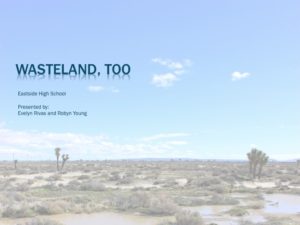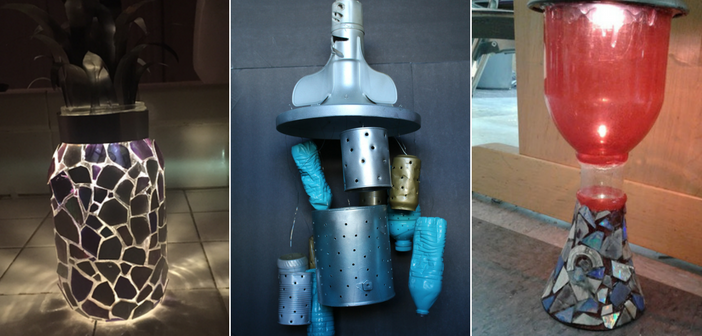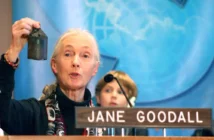These days artists are doing brilliant things with recycled trash. There is one artist who turns his own personal trash into art by projecting light through it, another who recreated the Mona Lisa out of plastic, and another who made a magnificent beached mermaid scene out of 10,000 plastic water bottles to draw attention to plastic pollution. But what is equally as incredible as these professionals are students who are making brilliant sculptures out of trash they’ve collected. Students at Eastside High School in Lancaster, CA are calling this project “Wasteland, too,” and it is based off of a similar project that their teacher Evelyn Rivas did a few years ago called “Wasteland” in which her students made flower sculptures out of recycled trash. This year, the 200 students involved stepped it up a notch, making fully-functional solar light sculptures out of trash!
The trash sculptures were just one component in a brilliantly-crafted lesson on how illegal dumping can affect one’s community — the people, the animals, and the surrounding environment. In order to visualize why their community has problems with illegal dumping, they created a community map of where the dump sites are in relation to other landmarks.

Eastside High School’s Roots & Shoots Community Map
Students and families learned about the appropriate ways to dispose of trash and unwanted items, and the legal ramifications of illegal dumping from community collaborators and guest speakers. Karen Tandler of the District Attorney’s office, as well as Donald Watkins and David Jones, representatives of the city of Lancaster, were among these speakers. The students also got to greet a real owl when representatives from Parks and Recreation came to share about how illegal dumping affects wild animals.
There are approximately 100 million tons of illegally dumped garbage lying around the world.
But you can’t learn about trash without getting your hands dirty. So the students ventured to some dump sites to clean up as well as to personally scavenge for the trash that they would be using to form their sculptures. They also participated in a nature walk, photographing illegal dump sites in preserved areas to really witness the harsh contrast of trash disposed of in nature.
Why does illegal dumping happen?
Illegal dumping happens because properly disposing of things costs a lot of time…and money.
Landfill rates can be quite high, and many items (like refrigerators) cannot be disposed of at landfills due to the toxic chemicals inside. There is a $15 minimum charge to dump 1 yard of junk at a landfill.
Why is it so harmful?
Illegal dumping pollutes the air and soil. It becomes a hazard to animals and humans and it diminishes the property value or tourism attraction of certain places. Illegal dumping is particularly a problem in rural areas because of the wide, open spaces and difficulty of catching someone in the act. This is bad news for the wildlife in these areas whose habitats are being infested with harmful foreign debris. If toxic materials aren’t disposed of in their proper designated region, the contents can spill onto land and seep into our ground and eventually into our water system.

What is the solution?
- First and foremost, you should consider reuse before you consider disposing of an item. Second hand stores take more than just clothing, they often accept things like kitchenware, furniture and bicycles. So check with your local Salvation Army, Goodwill, or other thrift stores so that you can save yourself some money, a trip to the dump and the environment.
- For items in which the sheer size is getting in the way of proper disposal, there are certain mobile services that can aid with removal. Seasonal bulk pickups vary per city, so check with your local waste removal and recycling companies. For instance, Waste Management provides one free bulky-item pickup per year per family to residents in several cities nationwide.
- For items that cannot be taken to landfills due to their toxic contents, there are specific companies that specialize in such things. For instance, 1-800-GOT-JUNK recycles refrigerators, appliances, mattresses and TVs.
- Sometimes drama and theater departments take old furniture to be used as props, so give your school or other drama group a call and ask them!
The students of EHS had a solution of their own: turn discarded possessions into repurposed treasures. Alyson Schill of Tree People presented to the group about creative sculpture ideas made with recycled materials. And then the wheels were spinning. The final product was a wonderful array of solar lights made out of anything from  broken mirrors to CDs to sponges. Their project was celebrated by the local community — they received awards from the Mojave Environmental Education Consortium and the Antelope Valley Illegal Dumping Task Force.
broken mirrors to CDs to sponges. Their project was celebrated by the local community — they received awards from the Mojave Environmental Education Consortium and the Antelope Valley Illegal Dumping Task Force.
Thank you to the students of Lancaster for shedding some solar light on this easily overshadowed topic! Here is a powerpoint presentation describing the steps of their innovative project.






